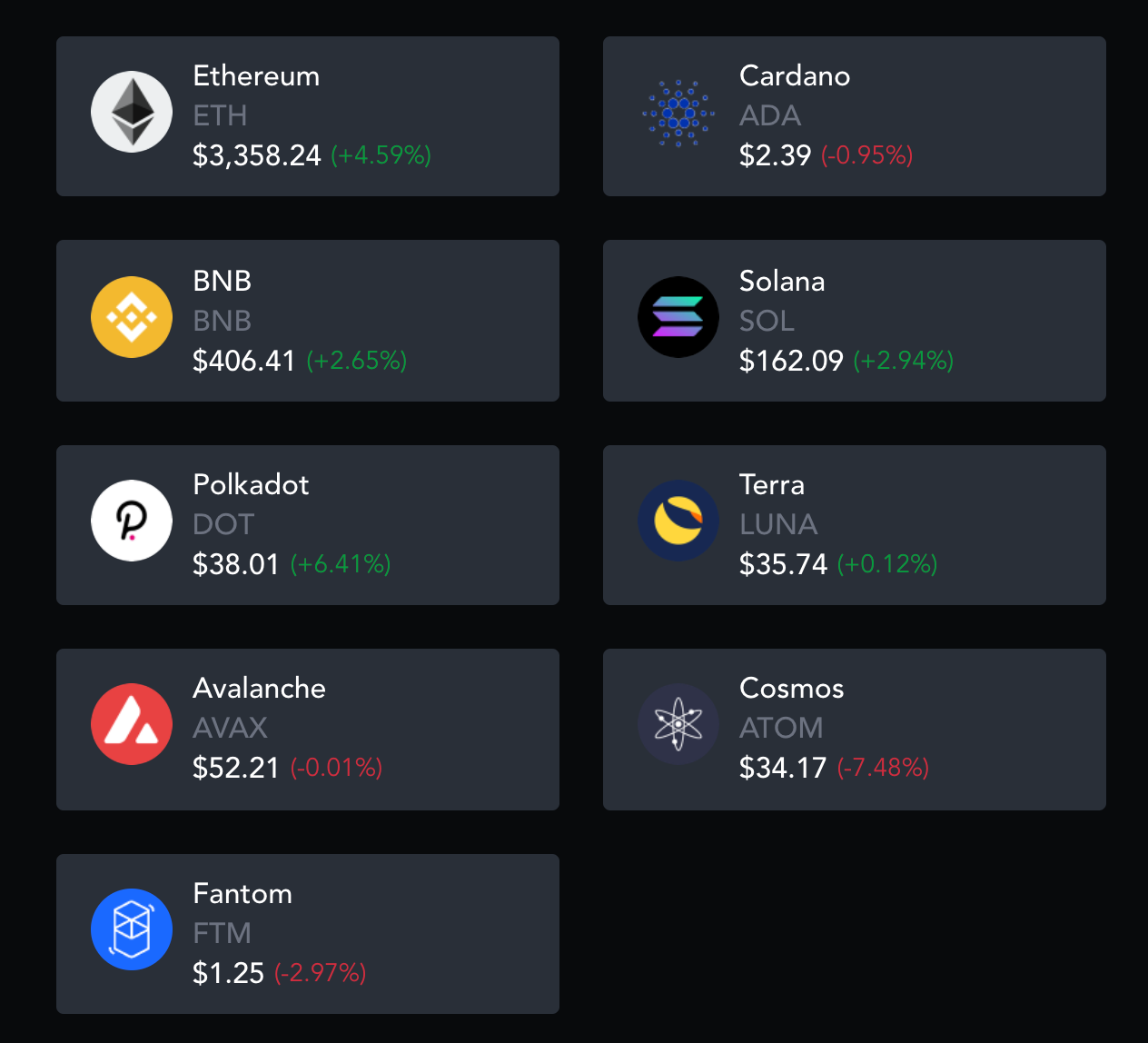Layer 2: The Next Big Crypto Trend
Smart-Contract Platforms
The race for smart-contracts has never been more alive. There’s a handful of smart-contract platforms gaining traction. And they showcase the potential for DeFi and NFTs. These are the hot topics of crypto and everyone wants to earn higher yields. Money seems to flow to whichever platform offers the best returns.
Most leading smart-contract platforms also incorporate highly liquid stablecoins and NFT marketplaces. It seems like each blockchain will showcase potential use-cases for gaming as well. It’s hard for investors to determine which blockchain they should add to their portfolios. Each smart-contract platform appears to boast the same functions and similar roadmaps. Luckily, on-chain metrics make it easier than ever to see where money is flowing.
The top 3 DeFi smart contract platforms by value locked are currently:
ETH
BNB
LUNA
But SOL, DOT, AVAX, and ADA will surely be competitors.
TVL is interesting because it’s hard to move money around after it’s staked, locked or earning yields. Once you’ve entered an ecosystem, it’s difficult to transfer funds to another. For this reason, new projects must build bridges to chains with higher TVL.
DeFi & NFT Mania
How long will DeFi and NFT mania last? It’s not hard to find a 100% yielding LP right now. Any new DeFi project will offer high yield in the form of its native token. And practically anyone could launch NFTs and sell them today. But those buying NFTs for millions likely didn’t buy their crypto for millions. They’re just diversifying crypto gains into new projects and potential store-of-values. This diversification into jpegs and stablecoins has stretched the industry to new levels.
Both DeFi and NFTs are here to stay for the long term, but it’s hard to know how long the mania will last. How do you know which platforms will keep their users? EOS and Tron were the most advanced blockchains during the peak of 2017’s bull run. But neither blockchain is climbing in market value or TVL when compared to aforementioned platforms. It’s difficult to predict the next trend. But there’s clearly value in connecting all of these chains and their native assets.
Nobody wants to unwrap wBTC, send to other exchanges or blockchains, and then wrap it again. Users want to seamlessly transact across multiple blockchains using stablecoins or wBTC. They want to move their stablecoins to LPs on other platforms. And they want their wallets to work with each blockchain without interrupting user-experience. End-users only care about the product and result. If you’re earning 100% plus APY, who cares if the product’s built on BSC, SOL, or ETH? Users just want high APY, cheap gas-fees and speedy transactions.
Layer-2 & IBC
The next big blockchain trend is IBC (inter-blockchain communication). The solution is really a middleware network, but it’s most commonly known as layer 2. Connecting every blockchain together will become invaluable as more and more smart-contract platforms roll-out. Right now, most of the chains are building their own highly privatized bridges. These centralized, cross-chain mechanisms pose an issue for any project building on them. They’re totally reliant on the protocol-layer blockchain.
And, we know, these blockchains don’t always work properly. Solana crashed yesterday and took quite a long-time to reboot the network.
The majority of users and builders still don’t show much interest in decentralization right now. The term is thrown around here and there, but nobody cares if Binance is centralized. There’s still plenty of Binance users because it has liquidity and high yield farming strategies.
Most new projects start off highly centralized. The more decentralized you start-off, the more chaotic things appear. We understand some forms of centralization are needed at the on-set. You probably don’t mind interacting with a centralized platform, but you want funds stored on a decentralized network. The same philosophy applies to dApp builders. They don’t mind bridging to centralized networks, but their dApp needs to live on decentralized infrastructure.
And many people have misconceptions about chains like SOL being highly decentralized. But we just witnessed a handful of people stop the chain from producing blocks entirely.
Points of centralization are easily overlooked so long as money is being made.
The future, however, will be based on true decentralization. Central points of failure open the door for governments to step-in. Remember, if a stablecoin or crypto product is regulated, it’s not decentralized.
Meanwhile, projects running on decentralized infrastructure will not worry about regulators. Layer 2 projects will connect centralized blockchains through a decentralized portal.
Many future crypto products, like DeFi and NFTs will live on layer 2 solutions. This second layer provides a decentralized option to avoid legal scrutiny or governmental control. Layer 2 dApps will maintain their technical longevity, supported by multiple blockchains. The application becomes immortal because it’s running on middleware.
DAPP Network
The DAPP Network is this decentralized layer 2 where applications will store, run, and provide anything valuable. You wouldn’t run solely on a protocol layer (ETH, SOL, or BSC) because it’s too risky.
DAPP Network bridges all blockchains to a single hub. Many different protocol layer blockchains will plug-in to DAPP. You could move your wrapped Bitcoin from ETH to other networks like BSC directly.
I mentioned Solana temporarily shut down on September 14th, 2021. Gavin Wood tweeted about the incident, saying “if you can’t run a full node yourself then it’s just another bank.”
DAPP Network’s Edge DSP allows anyone to run a node from their web browser. This feature prevents dApps from relying on a single protocol’s infrastructure. Users will not worry about moving, claiming, or unstaking their tokens if a protocol temporarily shuts down.
DAPP is the network’s incentive token and everything uses DAPP to function. You can think of DAPP as the economy powering other economies. DAPP Network makes decentralization easy for users and builders.
There’s a list of prominent, community-built DAPP Network services and tools here.
LiquidApps is the team who launched DAPP Network. They quietly built DAPP Network’s infrastructure for more than two years. But it’s finally ready to expand across major blockchains.
DAPP Network still has a very low market cap. It’s whitelisted on Bancor — the only major Ethereum DEX where you can find DAPP. But it’s scarcity may not last very long. The DAPP community has recently launched their own governance portal. This portal allows them to create initiatives and proposals. The network is officially owned by the community. It’s truly decentralized, using the best available technology.
DAPP Network is set to explode alongside the next big crypto trend. Layer 2 mania will test the bounds of what’s possible, just like DeFi and NFTs. But DAPP Network is one project building for the long-term. Stay tuned for more news and product updates as DAPP Network continues to grow.
Follow Wes.
Learn how to earn…
Become part of our community.
Follow our socials.
Subscribe to our podcast.
Subscribe to this publication.
It’s free (for now)






Every era has a different trend. Sometimes we can guess, sometimes we can't, but we definitely have to keep up with the innovations.
I imagine the economy of the future will be built on decentralized networks.
you are absolutely right the next blockchain trend is IBC inter-blockchain communication.
The initiative that achieves this without any problems will be great.
I want to especially thank you.
You explained blockchains, DAPP networks and what layer 2 is very simply and beautifully.
Thank you for your great article.